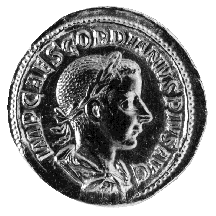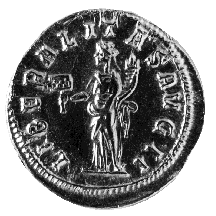



(117) Gordianus III - AV aureus, A.D. 240, 4.34 g. (inv. 91.219).
Obverse: Laureate, draped, and cuirassed bust of Gordianus r.; IMP(ERATOR)
CAES(AR)
GORDIANVS PIVS AVG(VSTVS): Imperator Caesar Gordianus, pious Augustus.
Reverse: Liberalitas standing l., with tessera in r. and cornucopia
in l.; LIBERALITAS AVG(VSTI) II: the second liberality of the Augustus.
Provenance: Ex Milton Holmes collection; Stack's, 1960.
Bibliography: H. Mattingly, E.A. Sydenham, and C.H.V. Sutherland, The
Roman Imperial Coinage IV.3: Gordian III to Uranus Antoninus (London
1949) 58.
The year A.D. 238 was one of the most chaotic in Roman history, with five
emperors coming to violent ends. The sixth Augustus of that year, Marcus
Antonius Gordianus, came to the throne at the age of thirteen, after the
deaths of his grandfather and uncle, Gordian I and II, and of the co-emperors
who replaced them, Balbinus and Pupienus. Probably first led by his mother,
then by the able praetorian prefect, Timesitheus, whose daughter he married
in A.D. 241, Gordian surprisingly remained in power for six years. His reign
was marked by war on the northern frontier and in Africa and in the East
by a Persian invasion. Gordian and Timesitheus went to meet the threat in
the East and pushed on to Mesopotamia, where Timesitheus died suddenly.
He was succeeded by his second in command, Philip, who soon murdererd Gordian.
Gordian's coin portraits assume the short-haired military type typical of
this period of soldier-emperors, but it does nothing to disguise the youthfulness
of his beardless, unlined face. On the reverse, Liberalitas with her tessera
and cornucopia refers to the largesse of Gordian's second liberality (see
no. 96), the occasion for which is unknown.
C.L.L.



All contents copyright (c) 1996.
Lawrence University
All rights reserved.